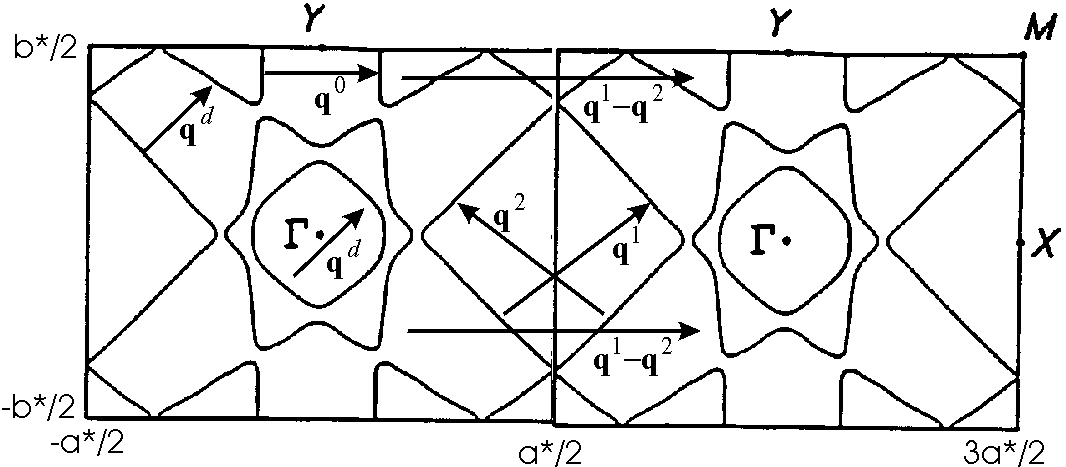Research at the Laboratory of Crystallography
Charge-density-wave compounds
One-dimensional (1D) and two-dimensional (2D) electronic crystals are metalic compounds with a highly anisotropic band structure. The reduced dimensionality has several consequences for the physical properties: the electrical conductivity is anisotropic and it is the largest along the direction of the 1D chains; Both 1D and 2D crystals may be unstable at low temperatures against the formation of a so-called charge-density-wave (CDW); Within the CDW state, the electrical conductivity is non-linear, and an extra contribution to the conduction is present at high electrical fields due to a sliding-CDW.
Responsible for the CDW phase transition is the fact that the energy of the electrons in the conduction band is lowered, when the structure becomes modulated with a wavevector that can act as a so-called nesting vector for the Fermi surface (Fig. 1). Because the Fermi surface can have any shape, the modulation usually is incommensurate with respect to the periodic lattice of the basic structure. The atomic modulations give rise to extra Bragg reflections in x-ray scattering at incommensurate positions between the main reflections of the parent structure. Measurement of their positions and intensities allows a complete characterisation of the CDW.

Fig.1: Fermi surface of the calculated electronic band structure of the phosphate bronze (PO4)4(WO3)8, together with the nesting vectors q1, q2, and q1-q2 as determined by x-ray scattering [5]. The nesting vector qd as suggested by the band structure calculation, is not found experimentally.
At the Laboratory of Crystallography we study CDW crystals by x-ray scattering in dependence on temperature using synchrotron radiation as well as laboratory instruments. The Maximum Entropy Method (MEM) is used to determine accurate electron densities, and to study the bonding characteristics in the normal and in the CDW state. Compounds presently studied include the layered transition metal dichalcogenides with 2D CDW's, like 1T-TaS2, 4Hb-TaSe2, and 2H-NbSe2 [1,2]; The 1D CDW chalcogenides NiTa2Se7 [3,4]; NbSe3 and (TaSe4)2I [5]. < and the phosphate bronzes (PO4)4(WO3)2m (m = integer), showing both 1D and 2D CDW's [6]. Particular interest pertains to the effect of doping on the physical properties in relation to the modifications of the CDW structure.
Literature:
[1] A. Spijkerman, J.L. de Boer, A. Meetsma, G.A. Wiegers and S. van Smaalen (1997): X-ray crystal structure refinement of the nearly-commensurate phase of 1T-TaS2 in (3+2)-dimensional superspace. Phys. Rev. B 56, 13757.
[2] J. Lüdecke, S. van Smaalen, A. Spijkerman, J. L. de Boer, and G.A. Wiegers (1999): The commensurately modulated structure of 4Hb-TaSe2 determined by X-ray crystal structure refinement. Phys. Rev. B 59, 6063.
[3] J. Lüdecke, M. Schneider, and S. van Smaalen (2000): Independent q and 2q distortions in the incommensurately modulated low-temperature structure of NiTa2Se7. J. Solid State Chem. 153, 152.
[4] J. Lüdecke, E. Riedl, M. Dierl, K. Hosseini, and S. van Smaalen (2000): The influence of niobium on the CDW transition of Ni(Ta1-xNbx)2Se7. Phys. Rev. B 62, 7057.
[5] S. van Smaalen, E.J. Lam and J. Lüdecke, J. Phys.: Condens. Matter 13, 9923- 9936 (2001).
[6] J. Lüdecke, A. Jobst, S. Geupel, S. van SmaalenPhys. Review B 64, 104105 (2001) (11 pages)
The structure of the two-dimensional, incommensurate charge-density wave in (PO2)4(WO3)8 at T = 20K
